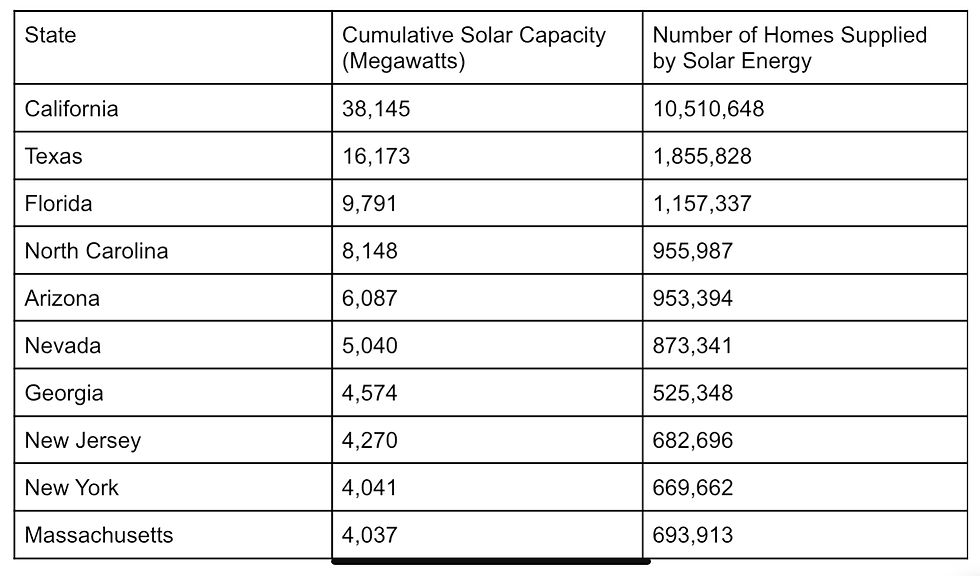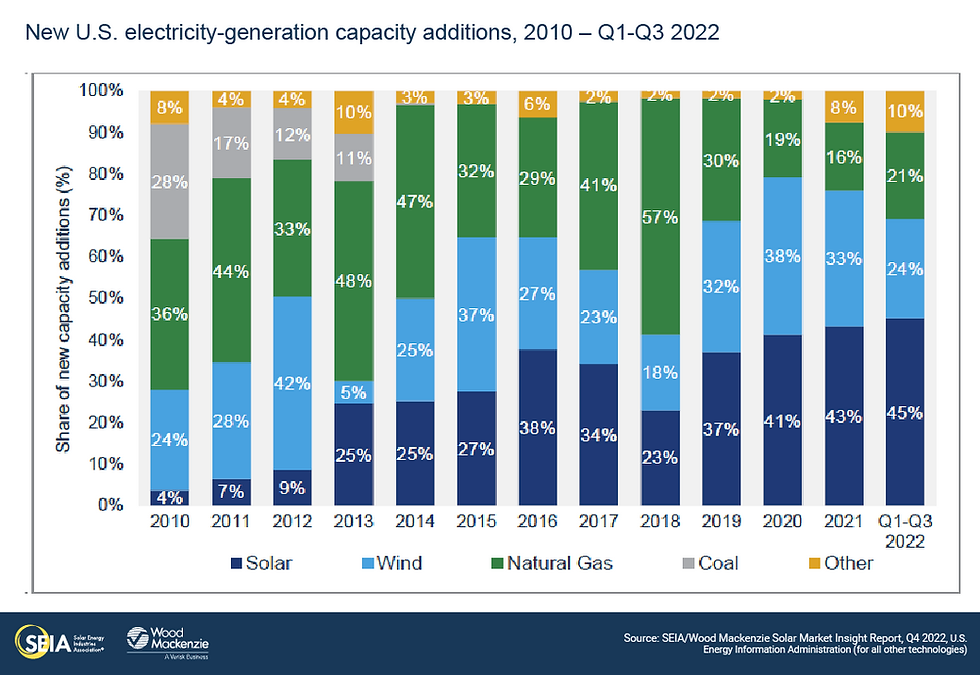Top Solar Energy States in the US: An Overview and Comparison
- ifeoluwa Daniel
- Feb 20, 2023
- 5 min read
Updated: Apr 8, 2023

Solar energy is becoming an increasingly important source of renewable energy in the United States, with many states adopting policies and incentives to promote the development and use of solar technology. While solar energy can be harnessed anywhere with sunshine, some states have been particularly successful in this regard, emerging as national leaders in solar energy production, installation, and innovation. In this article, we provide an overview and comparison of the top solar energy states in the US.
We'll examine the key factors driving the growth of solar energy in these states and explore how these states are working to achieve their renewable energy goals. By understanding the successes and challenges faced by these states, we can gain valuable insights into the future of solar energy in the US.
Top 10 States for Solar Energy
Based on the total installed and operational solar electric capacity as of the end of the third quarter of 2022, the Solar Market Insight Report provided a ranking of the top states across the nation. To put it into perspective, SEIA numbers also take into account the equal number of houses in each state that can be powered by that solar capacity.
Here are the current solar energy leaders in the United States:

Certain states appear on this scoreboard as would be expected (California has long been the solar king, and Florida isn't called the Sunshine State for nothing), while other states indicate unexpectedly emerging solar hotspots. You might be startled, for instance, to learn that some smaller northeastern states, including Massachusetts and New Jersey, are outperforming the competition. Yet, these findings demonstrate that the rules and economics guiding these installations have an equal impact; it's not only about land area and the availability of natural sunlight.
Renewable Energy Policies and Incentives in Top Solar Energy States
One of the reasons why these states are leading the way in solar energy implementation is because of their state-level policies and incentives. For example, California has a Renewable Portfolio Standard (RPS) that requires utilities to generate a certain percentage of their energy from renewable sources, including solar. Arizona, on the other hand, has a property tax exemption for residential solar installations.
Comparing the policies and incentives across these top solar energy states, we can see that they all have unique programs and initiatives to promote the growth of solar energy. Additionally, federal-level incentives such as the Investment Tax Credit (ITC) have also had a significant impact on the growth of solar energy across the country.
Solar Installation and Financing in Top Solar Energy States
In order to encourage more people to switch to solar energy, these top solar energy states also have strong solar installation and financing programs. For example, Massachusetts has a solar loan program that provides low-interest loans to residents for solar panel installations, while Arizona has a solar energy incentive program that offers rebates for installing solar panels on homes and businesses.
Comparing the solar installation rates between these top states, we can see that they all have high rates of solar panel installations, with California leading the way with over 10.5 million solar installations. These installation rates are a testament to the effectiveness of the solar financing and incentive programs in these states.
A Quick Look At The Top 5 States
California
California is the undisputed leader in solar energy in the United States, with the highest installed solar capacity of any state. As of 2022, California has installed over 38 gigawatts (GW) of solar capacity, enough to power over 10 million homes. The state has a goal of reaching 100% clean energy by 2045, and solar energy is playing a critical role in achieving that goal.
Texas
Texas may be known for its oil and gas industry, but it is also a leader in renewable energy, particularly wind and solar. As of 2022, the state has over 16 GW of installed solar capacity, and that number is expected to grow rapidly in the coming years. The state’s abundant sunshine and large land area make it an ideal location for solar installations, and there are a number of incentives and rebates available to those who install solar panels.
Florida
Florida is a state with abundant sunshine sunshine and policies that promote renewable energy. The growth of solar energy in Florida has been driven by a combination of factors, including declining costs, state tax incentives, and renewable energy goals set by local utilities. Despite this progress, Florida still lags behind other states in terms of its overall solar adoption rate, and more work is needed to fully realize the potential of solar energy in the state.
North Carolina
North Carolina is one of the fastest-growing solar energy states in the country, with over 8 GW of installed capacity as of 2022. The state’s renewable energy portfolio standard requires utilities to generate a portion of their electricity from renewable sources, which has helped to drive growth in the solar industry. Additionally, the state offers a number of incentives and tax credits to those who install solar panels, making it an attractive option for both residential and commercial customers.
Arizona
Arizona is a close second to California in terms of installed solar capacity, with over 6 GW of capacity installed as of 2022. The state’s sunny climate and flat terrain make it an ideal location for solar installations, and it has one of the highest solar capacities per capita in the country. Additionally, Arizona offers a number of incentives and rebates to homeowners and businesses that install solar panels, making it an attractive option for those interested in renewable energy.

Where Does Your State Rank?
Are you residing in a state that's at the forefront of solar adoption or one that's still catching up? Various factors that influence the varying levels of progress in different states include policy frameworks, rooftop availability for solar installations, the nation's inclination towards alternative energy sources, and even the state's seasonal exposure to solar radiation.
Based on a comprehensive analysis of these factors, SEIA's recent rankings position each state as follows:
Solar PV installation rankings in 2020, 2021, and Q1 to Q2 of 2022 in all 52 US states.

New U.S Electricity Generation
The U.S. installed 4.6 gigawatts (GWdc) of solar PV capacity in Q3 2022 to reach 135.7 GWdc of total installed capacity, enough to power 24 million American homes. Solar has accounted for 45% of all new electricity-generating capacity added in the U.S. through the first three quarters of the year 2022. Residential solar had another record quarter with 1.57 GWdc installed.

As We Enter The Future
The top solar energy states in the US have made significant strides in promoting the adoption of renewable energy. With their respective policies, incentives, and infrastructure, they have made it easier for individuals and businesses to invest in solar energy systems.
Whether or not you reside in any of the top solar energy states, you are in a great position to take advantage of these benefits and switch to solar power. You could be a homeowner, business owner, or looking to invest in renewable energy, solar is a wise and sustainable choice.
At IntegrateSun, we offer comprehensive solar financing and installation solutions to help you make the transition to solar power.
If you’re interested in becoming one of the millions of Americans who have made the switch to solar panels, contact us today to get an instant quote. Doing so will help you take the first step toward a cleaner and more sustainable future.



